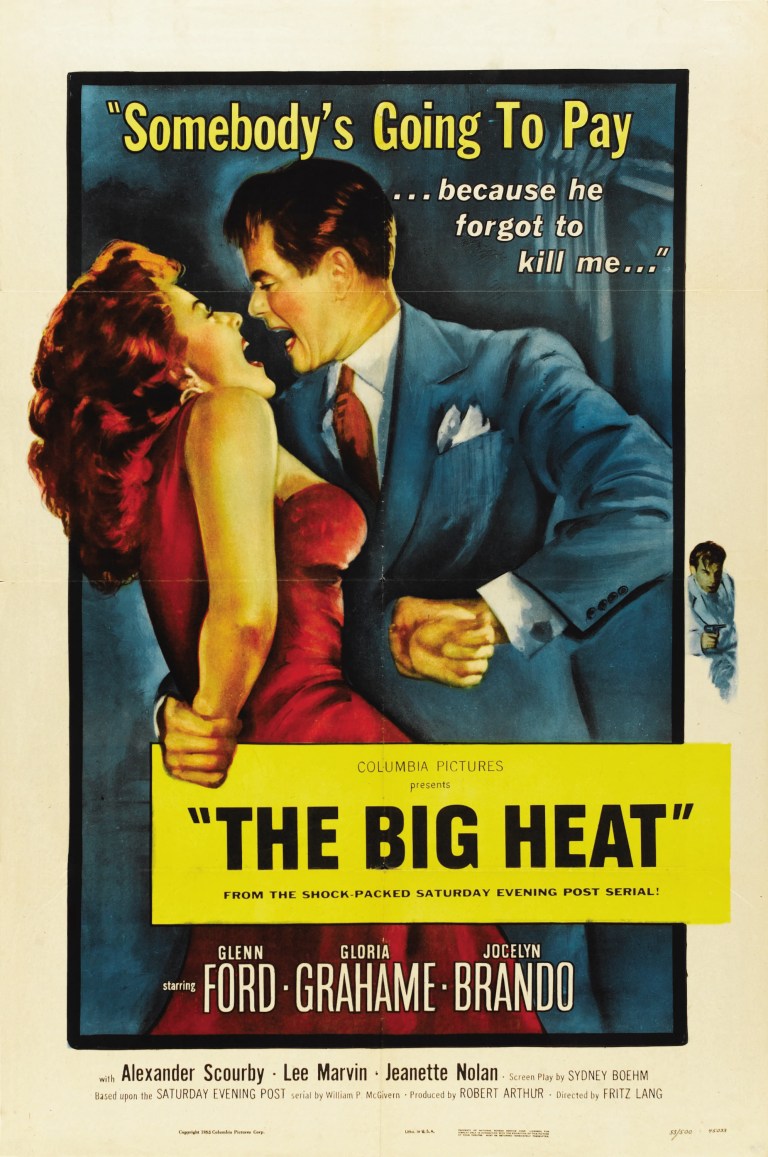Toward the end of Fritz Lang’s 1953 film noir, the detective Dave Bannion suddenly realizes that he has been double-crossed. The widow of a slain policeman reveals that she was complicit in her husband’s murder. In a rage, Bannion pushes her into the mantlepiece and puts his coarse hands around her neck. “With you dead,” he snarls, “the big heat follows,” and he believes that all the criminals in the city will be exposed.
This moment in and of itself is unexpectedly intense, because Lang presents Dave Bannion as an exemplar of conventional manhood. He is a detective who conducts routine investigations. He is married to a doting wife who cooks him steaks for supper. He is the father of a small child who begs him to recount a bedtime story. Then, Bannion’s fellow officer Tom Duncan is murdered, and he becomes subsumed in sordid society. He encounters a conniving political boss, a ruthless gangster and his gregarious girlfriend, and a maleficent auto mechanic. By toiling on the wrong side of the tracks, Bannion uncovers a colossal conspiracy, but Lang unearths something even more disturbing than rampant wrongdoing. By examining Bannion’s exploits, Lang reveals that American society is colored with crime and cruelty.
Lang is an odd director to comment on American mores. He did not come to this country by choice, but only because the Nazis drove him out of Europe. He found employment in Hollywood because of his distinguished resume. In the Weimar period, Lang had been one of Germany’s preeminent directors. He made the landmark science fiction film “Metropolis” and the seminal thriller “M.” Yet, his films were never escapist entertainments. As the critic Siegfried Kracauer observed in his study of the German cinema, “From Caligari to Hitler,” Lang’s films always responded to contemporary developments, even if the stories they conveyed were fantastical. For example, Lang’s 1922 film “The Testament of Dr. Mabuse” focuses on an upstanding man who is hypnotized by a mad scientist. Kracauer argued that “the film foreshadows Nazi practices” because its plot parallels Hitler’s seduction of the bourgeoisie. As Kracauer notes, some of Dr. Mabuse’s maxims, like “‘mankind must be thrown into an abyss of terror’” reflect fascist philosophies.
In the postwar period, however, Lang was not fascinated by Joseph McCarthy, who could be construed as a Dr. Mabuselike demagogue. Rather than find terror in paranoiac speeches, Lang discovered it under the peaceful façade of suburbia. Middle-class Americans yearned to live in model towns like Levittown, New Jersey. In these developments, all houses were affordable but identical, and they fostered a lifestyle of unbounded consumption. An ad for Levittown describes some features of the homes — “air conditioning, rich wall-to-wall carpeting…sliding glass doors to patio area, complete landscaping, 2-car garage.” In an abode armored with all these amenities, what could go wrong?
Everything, Lang asserts. Dave Bannion lives in a Levittown-like home. All the rooms in the house and spacious and comfortable, and his kitchen is sparkling clean. Everyone abides by prescribed roles, especially Bannion’s wife. She is introduced as she makes dinner in the kitchen. Her only problem seems to be getting their child to bed at an appropriate hour. She doesn’t drink or smoke. Instead, she simply “samples” his beer or cigarette. She moans every time he has to answer the phone. She knows that duty beckons him, and she cannot live without him.
Interestingly, the trouble begins when she does something out of the ordinary—she answers the telephone instead of him. She is shocked. Even in Levittown, you can receive obscene calls. Their quaint life soon comes undone. One evening, when the car exits the garage, it explodes. The criminals have weaponized a key component of Bannion’s existence. The wreck causes so much damage that Bannion must evacuate the house. By the end of the film, even the most banal consumer objects have become armaments in an atrocious arsenal. A hot pot of coffee allows the gangsters to disfigure their victims.
In some sense, Lang’s critique of postwar culture anticipates Andy Warhol’s renowned “Death and Disaster” series. Beginning in 1962, Warhol became increasingly fascinated with the macabre. He asked newspapers for photographs that they deemed too gruesome to print and silkscreened them on canvas. Even vivid colors cannot lessen the disturbing qualities of these images. In paintings like “Five Deaths on Turquoise,” Warhol directs our attention to a modern tragedy—bodies, mangled and crushed by a car. The art historian Thomas Crow asserts that Warhol depicts the moment when “the supreme symbol of consumer affluence, the American car of the 1950s, lost its aura of pleasure and freedom to become a concrete instrument of sudden and irreparable injury.” Ultimately, Warhol offers “a stark, disabused, pessimistic vision of American life.”
The same adjectives can be used to describe Lang’s vision. Unlike Warhol, however, Lang does not believe that consumer culture has gone awry. Under the lustrous patina, there is an engulfing abyss. Over the course of “The Big Heat,” Dave Bannion and his whole milieu are swallowed by it. That’s why his encounter with the policeman’s widow is so striking. Bannion believes that “the big heat” is coming in the future, but he does not realize that he is already under fire.
Contact Amir Abou-Jaoude at amir2 ‘at’ stanford.edu.
